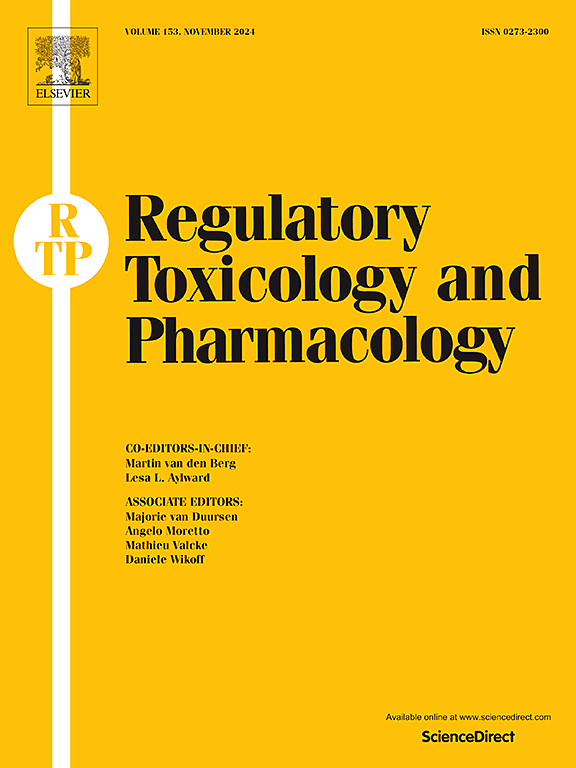Mutagenicity and genotoxicity evaluation of 15 nitrosamine drug substance-related impurities in human TK6 cells
IF 3
4区 医学
Q1 MEDICINE, LEGAL
引用次数: 0
Abstract
Nitrosamine drug substance-related impurities (NDSRIs) are a sub-category of N-nitrosamine drug impurities that share structural similarity to the corresponding active pharmaceutical ingredient. The mutagenicity of NDSRIs is poorly understood. We previously tested a series of NDSRIs using the Enhanced Ames Test (EAT). In this follow-up study, we further examined the genotoxicity and mutagenicity of 15 of these NDSRIs in human TK6 cells. Seven EAT-positive NDSRIs, including N-nitroso-nortriptyline, N-nitroso-fluoxetine, N-nitroso-desmethyl-diphenhydramine, N-nitroso-duloxetine, N-nitroso-lorcaserin, N-nitroso-varenicline, and N-nitroso-sertraline, induced concentration-dependent increases in micronuclei after bioactivation with hamster liver S9. These NDSRIs were also mutagenic in the TK and HPRT gene mutation assays, consistent with their positive EAT results. In the presence of hamster liver S9, the eight EAT-negative NDSRIs were negative in the micronucleus assay and negative for mutation induction. Using TK6 cells endogenously expressing a single human cytochrome P450 (CYP), we found that CYP2C19, CYP2B6, CYP2A6, and CYP3A4 are key enzymes activating the genotoxicity and mutagenicity of these NDSRIs. Overall, the hamster S9-mediated TK6 cell mutagenicity results agreed with those observed in the EAT, indicating consistency in the mutagenic responses produced by NDSRIs across different testing systems. These data support the use of EAT for hazard identification and safety assessment of NDSRIs.
15 种亚硝胺药物相关杂质在人类 TK6 细胞中的突变性和遗传毒性评估。
亚硝胺药物物质相关杂质(NDSRIs)是 N-亚硝胺药物杂质的一个亚类,与相应的活性药物成分具有结构相似性。人们对 NDSRIs 的致突变性知之甚少。我们曾使用增强艾姆斯试验(EAT)对一系列 NDSRIs 进行过测试。在这项后续研究中,我们进一步检测了其中 15 种 NDSRI 在人类 TK6 细胞中的遗传毒性和诱变性。七种 EAT 阳性的 NDSRIs(包括 N-亚硝基-去甲替普林、N-亚硝基-氟西汀、N-亚硝基-去甲二苯海拉明、N-亚硝基-度洛西汀、N-亚硝基-洛卡色林、N-亚硝基-伐尼克兰和 N-亚硝基-舍曲林)在与仓鼠肝脏 S9 进行生物活化后会诱发浓度依赖性的微核增加。在 TK 和 HPRT 基因突变试验中,这些 NDSRIs 也具有诱变性,这与它们的 EAT 阳性结果一致。在有仓鼠肝脏 S9 存在的情况下,8 种 EAT 阴性的 NDSRI 在微核试验中呈阴性,诱导突变的作用也呈阴性。利用内源表达单一人类细胞色素 P450(CYP)的 TK6 细胞,我们发现 CYP2C19、CYP2B6、CYP2A6 和 CYP3A4 是激活这些 NDSRIs 遗传毒性和诱变性的关键酶。总体而言,仓鼠 S9 介导的 TK6 细胞诱变性结果与在 EAT 中观察到的结果一致,表明 NDSRIs 在不同测试系统中产生的诱变反应具有一致性。这些数据支持使用 EAT 对 NDSRIs 进行危害识别和安全评估。
本文章由计算机程序翻译,如有差异,请以英文原文为准。
求助全文
约1分钟内获得全文
求助全文
来源期刊
CiteScore
6.70
自引率
8.80%
发文量
147
审稿时长
58 days
期刊介绍:
Regulatory Toxicology and Pharmacology publishes peer reviewed articles that involve the generation, evaluation, and interpretation of experimental animal and human data that are of direct importance and relevance for regulatory authorities with respect to toxicological and pharmacological regulations in society. All peer-reviewed articles that are published should be devoted to improve the protection of human health and environment. Reviews and discussions are welcomed that address legal and/or regulatory decisions with respect to risk assessment and management of toxicological and pharmacological compounds on a scientific basis. It addresses an international readership of scientists, risk assessors and managers, and other professionals active in the field of human and environmental health.
Types of peer-reviewed articles published:
-Original research articles of relevance for regulatory aspects covering aspects including, but not limited to:
1.Factors influencing human sensitivity
2.Exposure science related to risk assessment
3.Alternative toxicological test methods
4.Frameworks for evaluation and integration of data in regulatory evaluations
5.Harmonization across regulatory agencies
6.Read-across methods and evaluations
-Contemporary Reviews on policy related Research issues
-Letters to the Editor
-Guest Editorials (by Invitation)

 求助内容:
求助内容: 应助结果提醒方式:
应助结果提醒方式:


